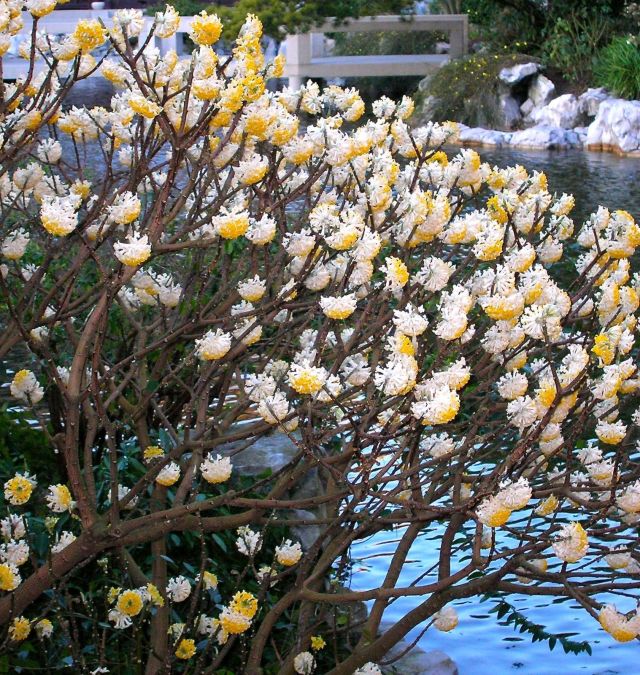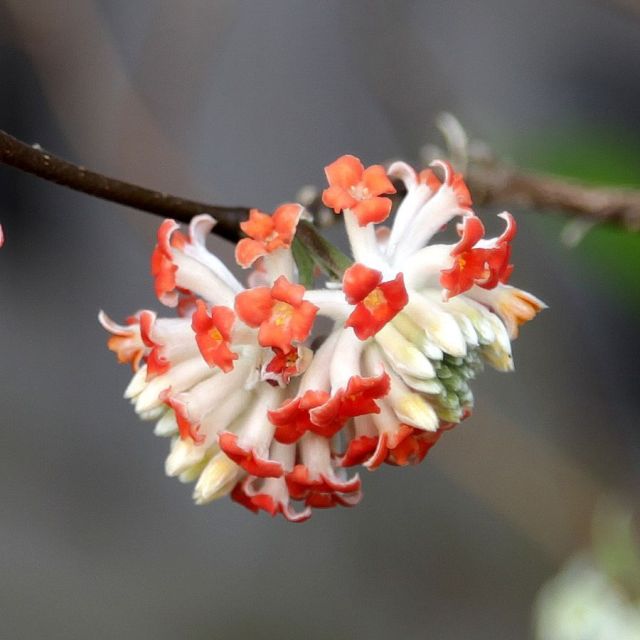Paperbush: A Nifty Winter-Blooming Shrub

Paperbush - known in nerd circles as Edgeworthia - is a robust shrub related to daphne with large leaves resembling those of tropical frangipani. In fall, those big, lush leaves turn clear yellow before dropping. Best of all are the fragrant flowers that appear in late winter – floury-looking white buds open to reveal clusters of soft, buttery yellow blossoms, sometimes starting as early as January and lasting through March.
Between the tropical summer look of the plant and the cheerful - and fragrant - winter flowers, it’s hard to think of a more versatile plant for a Pacific Northwest gardener.
Now's the time to find Edgeworthia in flower at plant nurseries. They can look dinky in their little nursery pots - a spindly brown trunk with a starburst of rubbery twiglets on top. But give it a year or two in the right spot in your garden and that little twig will be transformed into a statuesque shrub with real presence in your garden.
There are several types of Edgeworthia floating around in commerce: big, lusty Edgeworthia chrysantha and the named cultivars associated with it (Gold Rush, Snow Cream and others); the more refined and slightly smaller (and barely fragrant) plant sold as Edgeworthia papyrifera (which may or may not be a separate species); and the orange-flowering E. chrysantha 'Akebono', 'Red Dragon' or, simply, Rubra.

Edgeworthia chrysantha 'Red Dragon'. Photo courtesy of Portland's Lan Su, Classical Chinese Garden.
Whatever botanists wish to call it, it makes a striking addition to any garden, for its bold, tropical leaves and interesting winter silhouette enhanced by bright, fragrant flowers from winter to early spring.
When positioning it in your garden, just keep in mind the plant's ultimate size. E. chrysantha and its named forms can become hefty plants - ultimately, about 6' tall and 6-8' wide in time. Like Daphne, a close relative, Edgeworthia appreciates a somewhat protected spot in the garden, where late frosts won't zap the buds in January or February. The plant sold as Edgeworthia papyrifera is slightly smaller and has more delicate flowers and branching. It reaches about 5' tall and 6' wide. And the orange-flowered forms are about the same size and have the delicate branching of Edgeworthia papyrifera, but with beautiful reddish-orange flowers rather than pale yellow. (The fragrance in the orange forms is also barely detectable, if that matters to you.)
Edgeworthia thrives in rich, well-drained soil with regular summer water. The foliage can frizzle in blazing afternoon sun and reflected heat, doing best where it receives bright, dappled light or most of a day's sun.
Look for large specimens of the plant in bloom, beginning in the next few weeks, at Portland's Lan Su, Classical Chinese Garden in inner NW Portland and at the Bishop's Close Garden at Elk Rock in Dunthorpe. Find plants to buy from local nurseries by searching Plant Lust.
